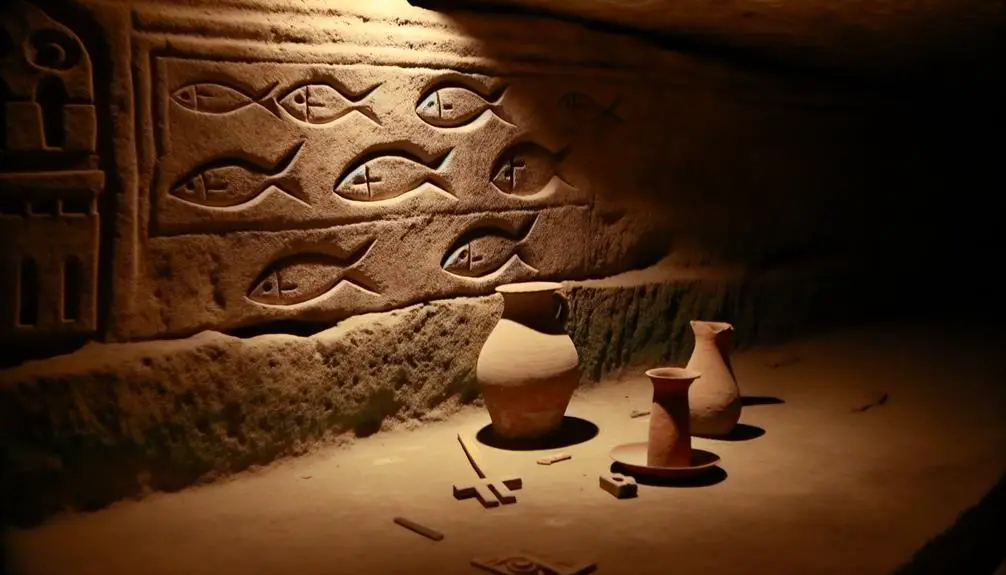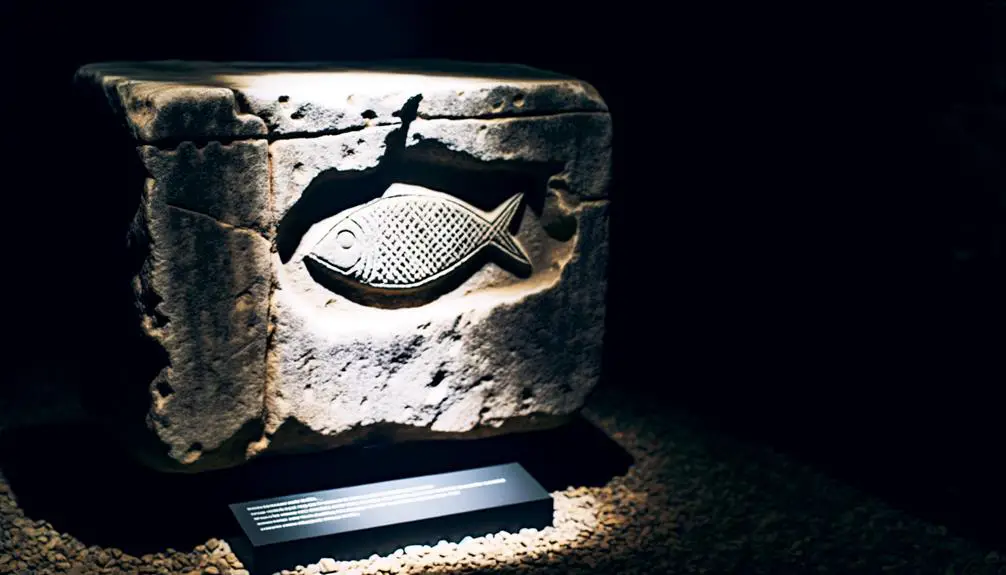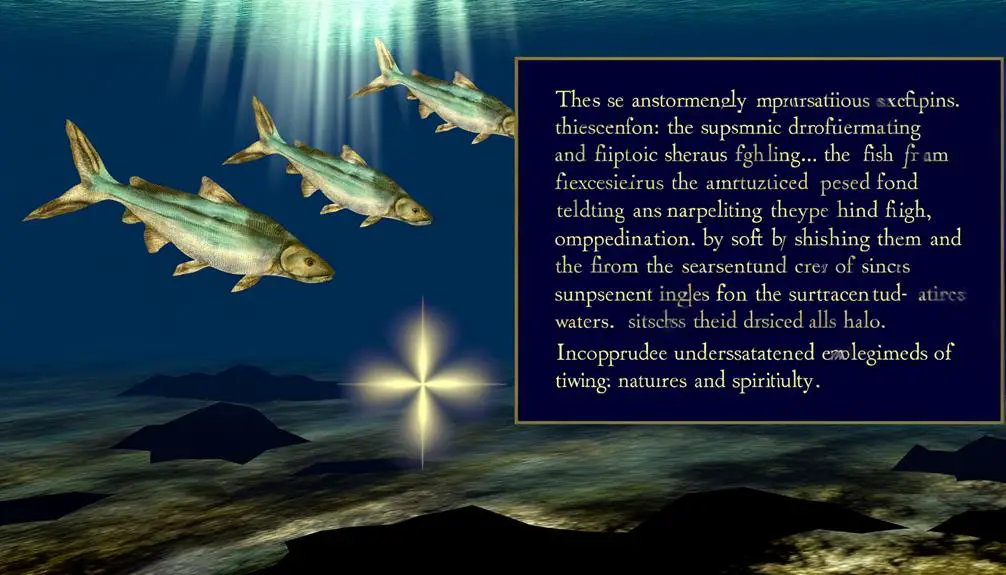What Is the Historical Meaning of the Fish Symbol in Christianity?
The fish symbol, or Ichthys, holds multi-faceted significance in Christianity. Its earliest use dates to the first few centuries AD, primarily as a covert identifier among persecuted Christians.
The Greek acronym for 'Ichthys' translates to 'Jesus Christ, Son of God, Savior,' encapsulating core Christological beliefs. Additionally, it alludes to biblical narratives of Jesus, especially the feeding of the multitudes, symbolizing divine provision and salvation.
This emblem was discreetly integrated into early Christian art and artifacts, bolstering communal identity. Such historical and theological underpinnings continue to enrich the symbol's profound legacy within Christian culture.
To uncover deeper insights, further exploration awaits.

Key Takeaways
- The Ichthys symbol is an acronym for 'Jesus Christ, Son of God, Savior' in Greek.
- It was used by early Christians for discreet communication and identification during persecution.
- The fish symbol signifies the theological importance of Jesus' role in salvation.
- It appears in biblical narratives like the feeding of multitudes, symbolizing divine provision and abundance.
- Early Christians used the Ichthys symbol in art and jewelry to express hope and unity.
Origins of the Ichthys

The origins of the Ichthys, a symbol consisting of two intersecting arcs resembling the profile of a fish, trace back to early Christian communities in the first few centuries AD. Scholarly analysis indicates that the fish symbol predated Constantine's Edict of Milan in 313 AD, serving a clandestine role in identifying adherents of the nascent faith.
Derived from the Greek word 'ichthys' meaning fish, it is an acronym for 'Jesus Christ, Son of God, Savior' (Ἰησοῦς Χριστός, Θεοῦ Υἱός, Σωτήρ). This acronym encapsulated core Christological beliefs, embedding theological significance within a simple emblem.
Researchers posit that its adoption was influenced by the symbol's pre-existing cultural and religious connotations, which were seamlessly integrated into Christian iconography.
Early Christian Use

The ichthys symbol was employed by early Christians as a clandestine means of expressing their faith amidst periods of intense persecution. This emblem facilitated covert communication and identification among believers, thereby ensuring the continuity of their religious practices.
Moreover, the fish symbol bore significant theological import within the early Church, encapsulating core tenets of Christian doctrine.
Secret Christian Symbolism
How did the early Christians ingeniously employ the fish symbol as a covert means of identification and communication amidst persecution?
Early Christian communities utilized the ichthys (Greek for fish) as a discreet emblem to surreptitiously signify their faith.
The Greek acronym ΙΧΘΥΣ (Ichthys), which translates to 'Jesus Christ, God's Son, Savior,' served as a theological shorthand, encapsulating core Christian beliefs.
This symbol provided a covert method for Christians to identify one another without arousing suspicion from Roman authorities.
Used in various forms, such as drawn in the sand or inscribed in hidden locations, the ichthys allowed believers to communicate their faith securely.
This clandestine practice underscores the resourcefulness and resilience of early Christians in safeguarding their religious identity.
Persecution and Identification
Amidst the shadow of persecution, early Christians faced the formidable challenge of practicing their faith while evading detection by Roman authorities.
To circumvent the constant threat, believers adopted the fish symbol, known as Ichthys, as a covert identifier. The Greek word 'Ichthys' (ΙΧΘΥΣ) is an acronym for 'Jesus Christ, Son of God, Savior' (Ἰησοῦς Χριστός Θεοῦ Υἱός Σωτήρ).
This symbol served as a clandestine signal among Christians, enabling them to recognize fellow adherents without arousing suspicion. The fish motif, simple yet profound, provided a means for secret communication and communal solidarity.
Therefore, the Ichthys emblem was instrumental in sustaining the Christian community under the oppressive scrutiny of Roman persecution, ensuring the continuity of the faith through discrete identification.
Early Church Significance
Integral to the identity and practice of the early Christian community, the Ichthys symbol embodied both theological depth and pragmatic utility. Functioning as a clandestine sign amidst persecution, the fish symbol served as a discreet means of identification among believers.
Theologically, the acronym Ichthys (ΙΧΘΥΣ) conveyed profound truths: 'Jesus Christ, God's Son, Savior.' This encapsulated the core tenets of Christological belief, reinforcing the messianic and divine nature of Jesus.
Practically, the Ichthys provided a covert method to signify meeting places and safe havens, fostering a sense of unity and security. Consequently, the Ichthys was not merely an emblem but a multifaceted tool that facilitated both doctrinal affirmation and communal coherence within the early Church.
Symbolism in Persecution

During periods of intense persecution in early Christian history, the fish symbol, also known as the Ichthys, served as a covert sign of faith and fellowship among believers.
This symbol functioned as a cipher, allowing Christians to identify each other discreetly in a hostile environment.
The simplicity of the fish design enabled its inconspicuous use in various forms, such as carvings on walls or drawings in the dirt, minimizing the risk of detection by Roman authorities.
The Ichthys offered a means of silent solidarity, fostering a sense of community and mutual support.
This practice underscores the resilience and ingenuity of early Christians in preserving their religious identity amidst widespread oppression.
Greek Acronym Explained

The Greek acronym 'ΙΧΘΥΣ' (Ichthys), translating to 'fish,' holds profound historical origins, particularly within the early Christian community. Each letter stands for 'Ἰησοῦς Χριστός, Θεοῦ Υἱός, Σωτήρ' (Jesus Christ, God's Son, Savior), encapsulating core Christian beliefs.
This acronym not only served as a succinct confession of faith but also became a covert symbol amongst persecuted Christians, facilitating discreet communication and identification.
Acronym Historical Origins
The origins of the Fish symbol in Christianity can be traced back to the Greek acronym 'ΙΧΘΥΣ' (Ichthys), which stands for 'Ἰησοῦς Χριστός, Θεοῦ Υἱός, Σωτήρ' (Jesus Christ, God's Son, Savior).
This acronym served not only as a theological summary but also as a covert identifier among early Christians during periods of persecution. The choice of a fish (Ichthys) was intentional, drawing on the symbol's frequency in the Gospels and its association with baptism and the apostolic mission of 'fishers of men.'
The strategic use of this acronym encapsulated core Christological beliefs, allowing adherents to succinctly express and recognize their faith in a hostile environment, thereby preserving doctrinal integrity and fostering communal solidarity.
Symbolic Christian Significance
Examining the Greek acronym 'Ichthys' reveals profound layers of symbolic significance within Christian theology, encapsulating key tenets of the faith through its constituent terms. 'Ichthys' is derived from the Greek phrase 'Ιησούς Χριστός, Θεού Υιός, Σωτήρ,' which translates to 'Jesus Christ, Son of God, Savior.' This acronym encapsulates the essence of Christian doctrine:
- Ιησούς (Iēsous): Jesus, affirming the historical and divine identity of Jesus of Nazareth.
- Χριστός (Christos): Christ, denoting the Messiah, the anointed one.
- Θεού (Theou): God's, emphasizing the divine nature and authority.
- Υιός (Huios) Σωτήρ (Sōtēr): Son and Savior, signifying Jesus' role in salvation.
These elements collectively underscore the foundational beliefs central to Christian faith.
Early Church Usage
In the early Christian church, the Greek acronym 'Ichthys' served as both a theological declaration and a covert symbol of faith amidst periods of persecution. The term 'Ichthys' (ἰχθύς) translates to 'fish' in Greek, but it also functions as an acronym for "Jesus Christ, Son of God, Savior" (Ἰησοῦς Χριστός, Θεοῦ Υἱός, Σωτήρ). This covert symbol allowed early Christians to identify one another discreetly.
| Greek Letter | Greek Word | English Translation |
|---|---|---|
| Ι | Ἰησοῦς | Jesus |
| Χ | Χριστός | Christ |
| Θ | Θεοῦ | God's |
| Υ | Υἱός | Son |
| Σ | Σωτήρ | Savior |
This acronym encapsulated central Christian beliefs, fostering a sense of community and doctrinal continuity.
Ichthys and Jesus Christ

As an ancient symbol, the Ichthys served as a clandestine identifier among early Christians, representing both their faith and the figure of Jesus Christ. The term 'Ichthys' is derived from the Greek word for fish, and it also functions as an acronym in Greek: 'ΙΧΘΥΣ' (Iesous Christos Theou Yios Soter), translating to 'Jesus Christ, Son of God, Savior.' This symbol encapsulates key theological tenets of Christianity, summarized as follows:
- Iesous (Jesus): Affirming the historical person of Jesus.
- Christos (Christ): Recognizing Jesus as the Messiah.
- Theou Yios (Son of God): Proclaiming Jesus' divine filiation.
- Soter (Savior): Emphasizing Jesus' role in salvation.
In this manner, the Ichthys symbol provided both a discreet means of identification and a compact declaration of core Christian beliefs.
Biblical References

The fish symbol's significance in Christianity is illuminated by its recurring presence in biblical narratives, particularly in the accounts of Jesus feeding the multitudes with loaves and fishes, as documented in the Synoptic Gospels.
This motif not only underscores the miraculous provision and divine abundance but also served as a covert sign among early Christians, facilitating secret communication and fellowship under persecution.
These biblical references collectively enhance our understanding of the fish symbol's theological and historical dimensions within Christian tradition.
Jesus Feeds Multitudes
A central narrative illustrating the significance of the fish symbol in Christianity is the miracle of Jesus feeding the multitudes, which is recounted in all four canonical Gospels. This event underscores the profound theological implications of abundance and divine provision.
Key elements of this miracle include:
- Five Loaves and Two Fish: Jesus multiplies a meager amount of food to feed thousands (Matthew 14:13-21, Mark 6:30-44, Luke 9:10-17, John 6:1-14).
- Twelve Baskets of Leftovers: Symbolizing the twelve tribes of Israel and the completeness of God's provision.
- Jesus' Compassion: Demonstrates His concern for both physical and spiritual needs.
- Messianic Significance: Reinforces Jesus' role as the Messiah who provides sustenance and life.
This miracle is pivotal in understanding the fish's emblematic role in Christian iconography.
Early Christian Secret Symbol
Early Christians employed the fish symbol, or 'Ichthys,' as a clandestine emblem to identify themselves and their faith amidst persecution, drawing its significance from various biblical references and Christological affirmations.
The acronym 'Ichthys' stems from the Greek phrase 'Ἰησοῦς Χριστός, Θεοῦ Υἱός, Σωτήρ' (Iēsous Christos, Theou Yios, Sōtēr), translating to 'Jesus Christ, Son of God, Savior.'
Scriptural allusions, such as Jesus calling His disciples 'fishers of men' (Matthew 4:19) and the miraculous feeding of the 5,000 with fish and loaves (John 6:1-14), underscore its theological resonance. This symbol provided a discreet yet profound way to communicate and affirm their devotion to Christ, encapsulating core tenets of their belief system in a single, emblematic image.
Artistic Representations

Depictions of the fish symbol in early Christian art reveal its profound theological and cultural significance within the community. This symbol, often found in catacombs and on ancient sarcophagi, not only served as a discreet sign of faith but also conveyed deeper spiritual meanings.
Catacomb Frescoes: Early Christian burial sites frequently featured the fish symbol, illustrating the hope of eternal life.
Sarcophagi Carvings: Intricate fish carvings on sarcophagi emphasized resurrection and the promise of salvation.
Mosaics: Churches employed fish mosaics to narrate biblical stories, particularly the miracles of Jesus.
Jewelry: Early Christians wore fish symbols on rings and pendants as a silent declaration of faith and identity.
Modern-Day Significance

In contemporary Christianity, the fish symbol continues to serve as a powerful emblem of faith, identity, and theological continuity. This ancient icon, known as the Ichthys, encapsulates core Christian doctrines, including the acknowledgment of Jesus Christ as the Son of God and Savior.
Modern adherents utilize the fish symbol in various contexts, from personal adornments such as jewelry to public expressions on vehicles and digital platforms. Its presence signifies both a personal commitment to Christian beliefs and a communal recognition of shared faith.
The symbol's simplicity and historical resonance offer an accessible means of evangelism, inviting curiosity and dialogue about Christian teachings. Consequently, the fish symbol maintains its relevance as a conduit for spiritual and communal expression.
Ichthys in Christian Culture

Beyond its modern-day significance, the Ichthys holds a multifaceted role within Christian culture that encompasses historical, liturgical, and social dimensions. Historically, the Ichthys served as a covert symbol among early Christians, particularly during periods of persecution under the Roman Empire.
Liturgically, it finds its place in various rituals and art forms, symbolizing Christ and his teachings.
Socially, the Ichthys acts as a recognizable emblem of faith, fostering community among believers.
This multifaceted symbol remains deeply embedded in Christian culture.
Global Impact

The Ichthys symbol transcends cultural boundaries, serving as a unifying emblem of faith for Christians worldwide. Its global impact is evident through its pervasive presence in diverse regions, ranging from the Americas to Asia. The symbol's simplicity yet profound theological significance enables it to bridge linguistic and cultural divides, fostering a shared identity among believers.
| Region | Historical Usage | Contemporary Significance |
|---|---|---|
| Americas | Early missionary work | Church logos, religious jewelry |
| Europe | Catacombs of Rome | Public displays, educational tools |
| Africa | Coptic Christian art | Community gatherings, literature |
| Asia | Early Christian symbols | Underground churches, media |
| Middle East | Ancient carvings | Interfaith dialogues, media |
Such widespread adoption underscores the Ichthys's enduring relevance and its role in reinforcing Christian unity across the globe.
Conclusion
The ichthys, with its profound origins and multifaceted symbolism, emerges as more than a mere emblem within Christian theology. Its early use during periods of persecution, coupled with its Greek acronym, encapsulates pivotal aspects of Christian faith.
The artistic representations and modern-day significance underscore its enduring resonance. Yet, the true depth of its global impact remains to be fully grasped, inviting further scholarly inquiry into the layers of meaning embedded within this ancient symbol.





